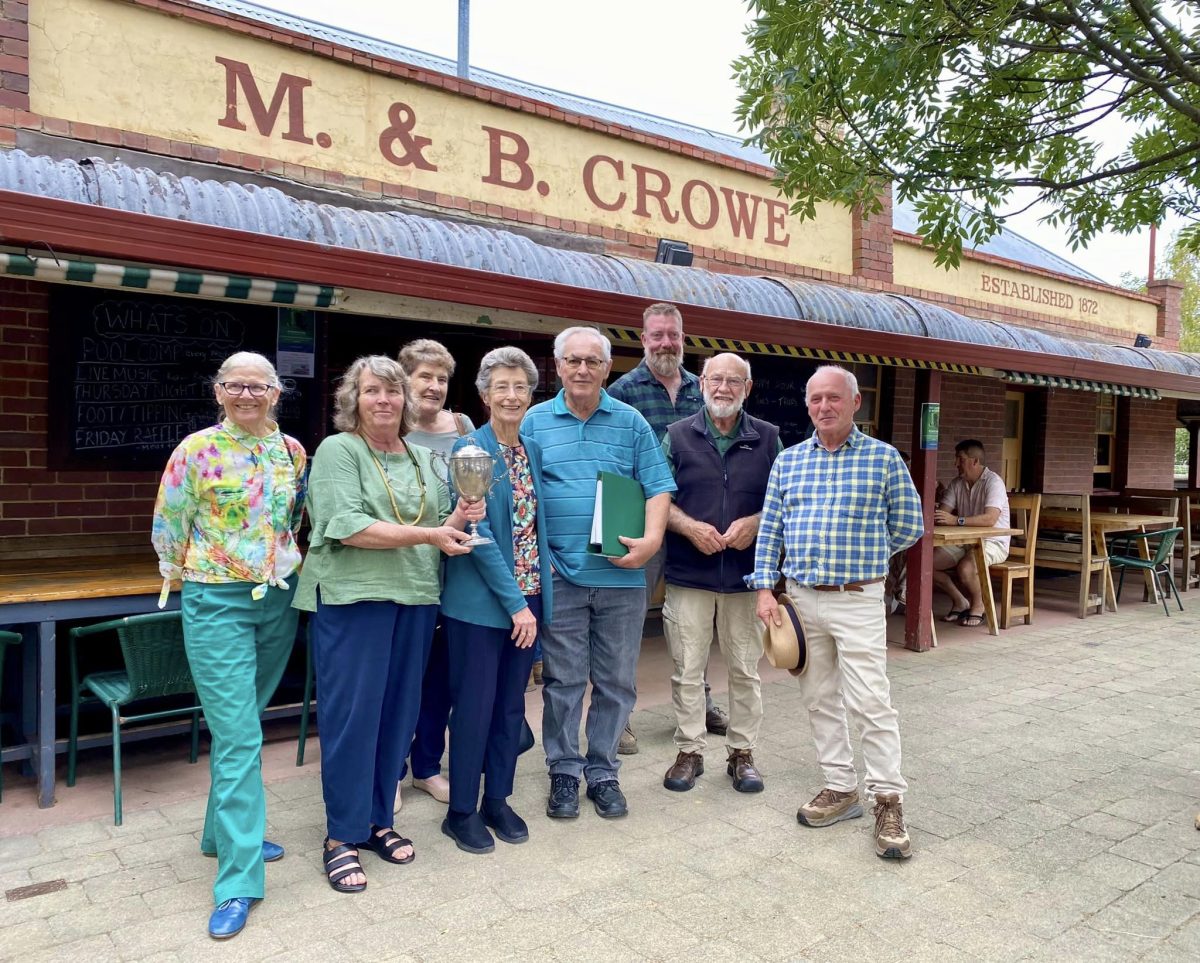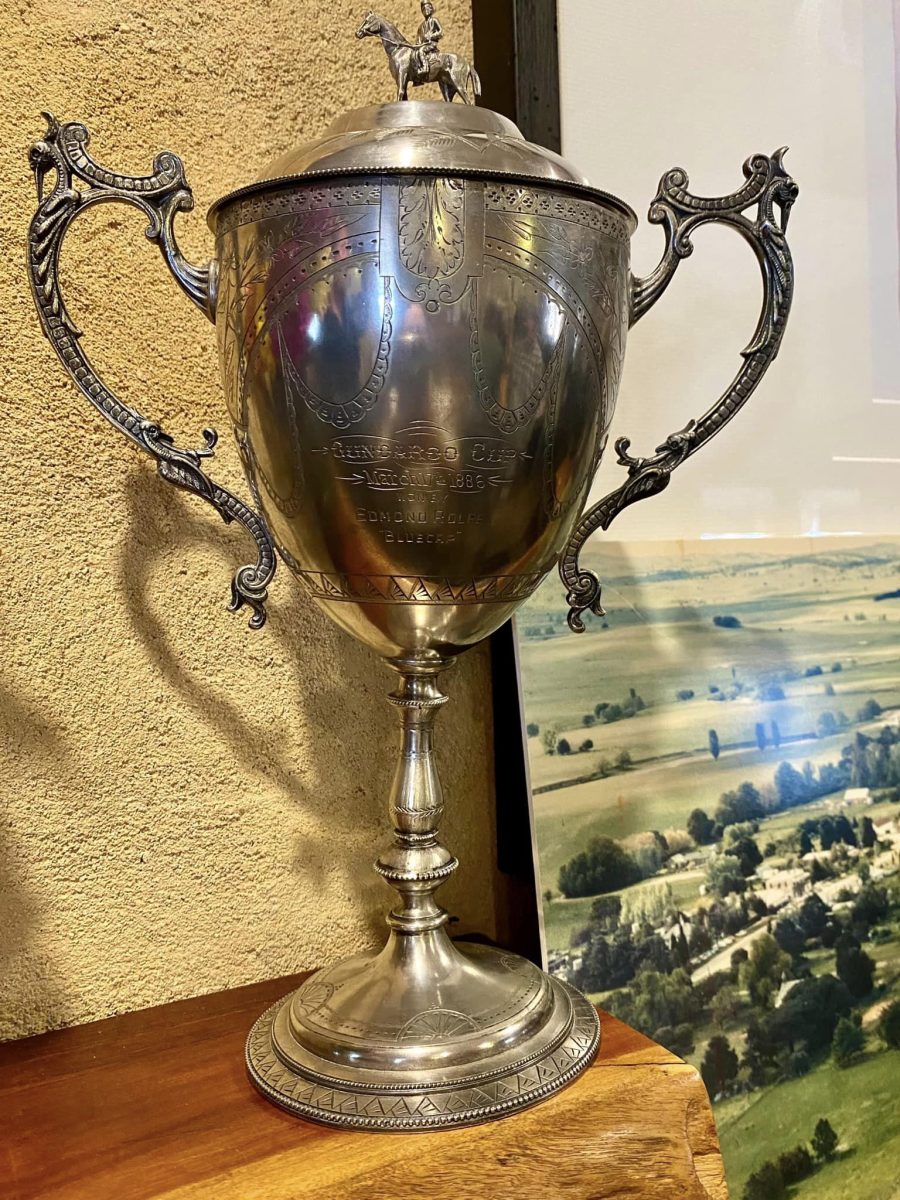
Locals and guests celebrate the donation of the Gundaroo Cup, from left, Esther Robinson, Sue Burns, Carol Richards, Joan Hibberson, John Hibberson, Andrew Martin, Ron Miller and Allan Gibson outside the Gundaroo Inn – formerly Crowe’s Wine Bar. Photo: Sheree Bamforth.
It’s the sort of generosity regional historical societies can only dream about.
President of the Gundaroo Historical Society, Sue Burns, was contacted by members of the Hibberson family. During a shed clean-out, they found what they knew had been in the family for years but hadn’t been sighted for almost as long – the 1886 Gundaroo Cup.
The cup, believed to have been kept secure in storage for most of its life, ended up with the Hibberson family which was connected by marriage to the Rolfe family – Edmund Rolfe won the 1886 race.
A keen horseman, Edmund’s family was one of the district’s first, establishing Gold Creek Station and their home Tea Gardens – known as Ngunnawal today. The Hibbersons came from Glenwood Station, via Hall.
“When they contacted us, the family said they had the cup in their possession and were keen for it to come back to Gundaroo, where the story began,” Ms Burns said. “We were absolutely delighted that it was going to come back here. It is a very generous gift.
“It’s sad these days that we lose a lot of history, but this gift reminds us that we did have a racing history in Gundaroo. Although it happened many years ago, it is important for us to record this history; otherwise, it gets lost forever.”
The 1886 Gundaroo Cup was held on St Patrick’s Day, so it was fitting for members of the Hibberson family, including Joan and John Hibberson, to come out to Gundaroo on that day to hand over the cup – albeit 138 years later.
The location was also fitting – the Gundaroo Inn formerly known as Crowe’s Wine Bar, with the late publican Matt Crowe a keen punter.
“Matt loved a bet,” Ms Burns said, “and he had a few racehorses back in the day.”
To mark the occasion, the Gundaroo Historical Society put on a display for the Hibberson and Rolfe families, giving them a taste of the village’s racing history – a history that did not always involve horses.
Vice-president of the society, Ron Miller, spoke about the variety of races held in the village, from the first event in 1866 to the Gundaroo Gallops in the 1970s and the Bush Festival that morphed into bush races.
The 1866 event, he said, was held on 24 May and was run to mark the Queen’s Birthday. The day even finished regally, with a celebration ball at the newly opened Royal Hotel.
The race was postponed the following year because of wet weather and was rescheduled to St Patrick’s Day, perhaps banking on the luck of the Irish for better weather.

The Gundaroo Cup, won by Edmond Rolfe on 17 March 1886 has been donated to the Gundaroo District Historical Society. Photo: Sheree Bamforth.
The next race, held on 18 March 1872, was perhaps the most colourful in its history, according to Mr Miller.
“[It was] notable for two things: In one race all horses were owned by the same person; and at the end of the day ‘some youngsters took the liberty of galloping around the course …’ running down the clerk of the course (and his horse) when he tried to stop them. No injuries incurred. Court reports following each St Patrick’s Day regularly recorded an incident or two from the day.”
But it was the 1886 cup that now has special meaning for the village, thanks to the Hibberson and Rolfe families.
In later years, the Gundaroo Gallops proved popular for the small community, when the event was held on the Edlington family’s Bairnsdale property on the river flats at the western end of Harp Street. It included not only horse races, but according to The Canberra News, the World Snail Racing Championships.









